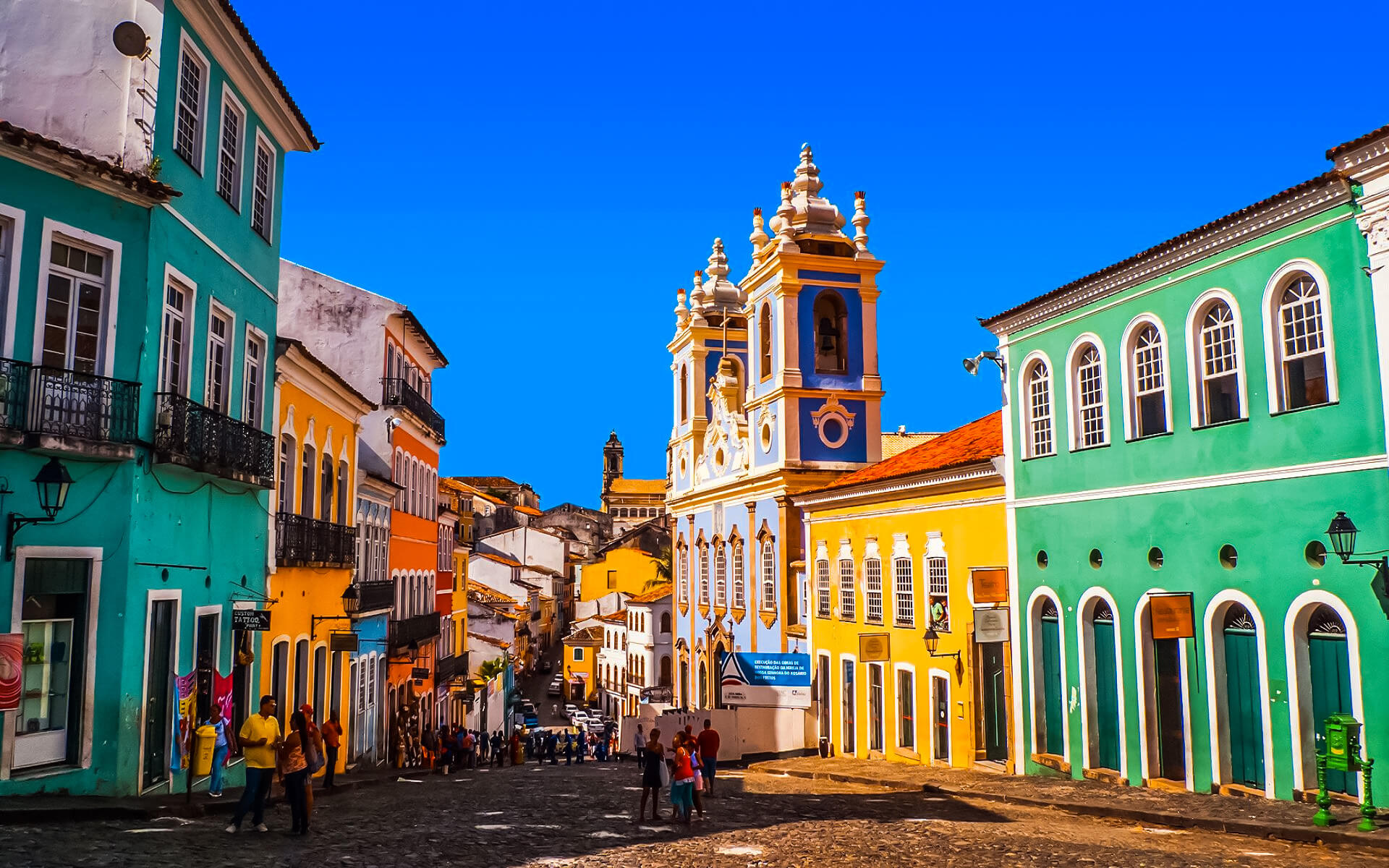Salvador is the capital of Brazil’s Bahia state. It is regarded one of the birthplaces of Brazilian culture due to its attractive Old Town (a UNESCO World Heritage Site), dynamic musical scene, and renowned Carnaval festivals.
Salvador has one of the longest coastlines in Brazil. Between the High and Low Cities, there are 80 kilometers (50 miles) of beaches, ranging from Inema in the railroad neighborhood to the Praia do Flamengo on the opposite side of town. While the beaches of the Low City are surrounded by the waters of All Saints Bay (the country’s largest bay), the beaches of the High City, from Farol da Barra to Flamengo, are surrounded by the Atlantic Ocean. Porto do Barra Beach is an anomaly, since it is the only beach in the High City that is situated inside All Saints Bay.
The beaches of the city vary from tranquil inlets good for swimming, sailing, diving, and underwater fishing to open sea inlets with high waves popular with surfers. Additionally, there are beaches that are bordered by reefs, generating natural stone pools that are perfect for youngsters.
Numerous retail malls service the city, including Shopping Iguatemi, Shopping Salvador, Shopping Barra, and Shopping Paralela.
Salvador has four parks, designated as Jardim dos Namorados Park, Costa Azul Park, City Park, and Pituaçu Park.
Jardim dos Namorados is next to Costa Azul Park and is a 15-hectare area near Pituba, where many families vacationed in the 1950s. It was opened in 1969 as a recreational area. It was completely renovated in the 1990s, with the addition of a 500-seat amphitheater, sports courts, playgrounds, and parking for vehicles and tourist buses.
The City Park is a critical preservation area for the Atlantic woodland. It was entirely rebuilt in 2001, transforming it into a contemporary social, cultural, and recreational space. The new park encompasses 720 square meters of green space in the heart of the city. Among the attractions is Praça das Flores (Flowers Square), which is surrounded by over 5,000 decorative plants and flowers.
Apart from its natural setting, the park features a dedicated infrastructure for children, with a specific calendar of activities held each October.
Pituaçu Park, established by state law in 1973, has an area of 450 hectares and is one of the few urban ecological parks in Brazil. It is bordered by Atlantic woodland, which is densely forested and home to a diverse range of flora and animals. Additionally, the park has an artificial pond that was constructed in 1906 beside the Pituaçu Dam for the purpose of supplying water to the city.
There are several recreational opportunities, ranging from cycloboat excursions on the pond to a 38-kilometer-long (24-mile-long) cycloway that circles the whole reserve. Additionally, the park has a museum. Espaço Cravo is an outdoor museum comprised of 800 works by Mario Cravo, including Totems, winged and three-dimensional creatures, as well as sketches and paintings.
ORIENTATION
Salvador is located on a peninsula on Brazil’s north-east coast, protecting the expansive Baa de Todos os Santos (“All Saints Bay”) from the Atlantic Ocean. The city is Brazil’s third biggest, extending inland for dozens of kilometers from the shore. The majority of tourists go toward the coastal neighborhoods clustered around the point where the bay joins the ocean. Salvador, Brazil’s climate is tropical, with rainforests and rich flora.
A 100m cliff spans the length of the bayshore, separating the city into Cidade Alta, which is located on the cliff, and Cidade Baixa, which is located by the bay. The former is home to Pelourinho, the ancient city center, which crams historical landmarks, colonial architecture, museums, restaurants, pubs, hostels, artisanal stores, and music/dance/capoeira schools into a handy, though tourist-infested, network of twisting cobblestone lanes. The latter is a commercial hub with a high volume of bus travel from all across Salvador.
Outside of this region, other beach districts continue northeast along the Atlantic coast from the peninsula’s tip. Barra, on the peninsula’s tip, is the primary alternative departure point for Pelourinho, while the chic districts of Rio Vermelho and Amaralina, to the northeast, provide a nightlife that is less focused toward the international tourist business. Beyond them lies the neighborhood of Itapuã, which has an active beachside nightlife and a low number of international tourists. There are miles and kilometres of beautiful beaches north of there, all of which are accessible by bus.
Beyond Pelourinho, the bayshore shoreline has a more calm mood and a more localized, but less picturesque, beach scene. Salvador’s interior is where the “new city” has emerged, with residential areas, retail megaplexes, and winding motorways that may be rather alienating without a companion to guide you around.
Local locals relish the opportunity to demonstrate their unusual dance and musical abilities to visitors. Additionally, residents are regarded as among of the kindest people on the globe. The majority of local folks welcome tourists with open arms.


